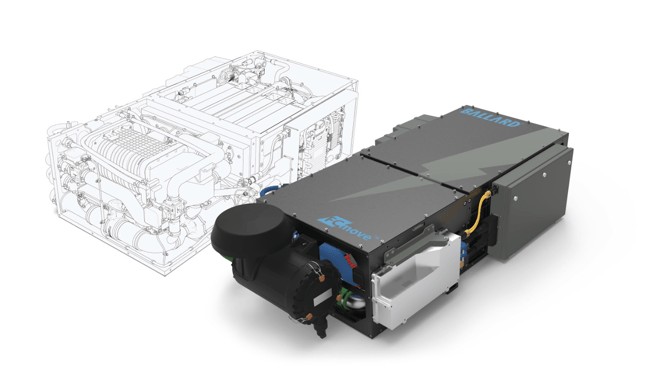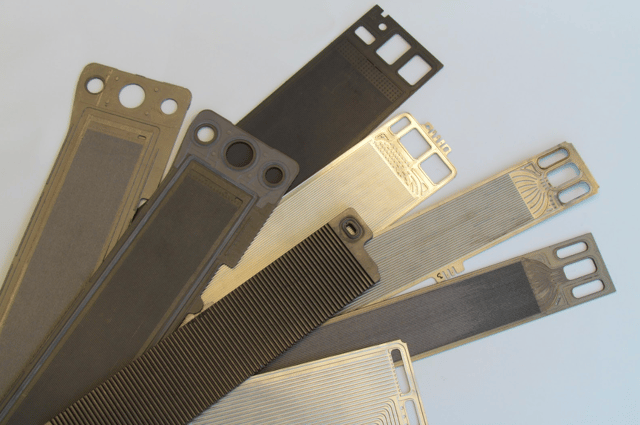In today’s article, you’ll learn how, at Ballard we are innovating our fuel cell production processes to drive down costs and maximize efficiencies.
Our Director of Advanced Manufacturing, Dr Lee Sweetland, shares key information about our process improvements including:
- how our new technology can create a complete membrane electrode assembly (MEA) in just two and a half seconds
- four important ways Ballard has tackled fuel cell cost reduction, and
- how Ballard is working to improve sustainability of our products and operations
 Let’s get started with our conversation!
Let’s get started with our conversation!
Thanks for speaking with us today Lee! So what is your area of expertise at Ballard?

I am always looking to advance technology to deliver disruptive processes that can game-change, an interest that started during my PhD to revolutionize water purification.
I worked with Johnson Matthey PLC for 18 years in many operations roles, but lastly as Manufacturing Technology Director in the New Markets sector group. I've now been with Ballard for almost two years.
At Ballard, my team has two main responsibilities:
Firstly, identifying and installing new production processes and operational technology (OT) solutions that will enable the scale up of the industry from the low millions of membrane electrode assemblies (MEAs) that are produced to date, to the tens or hundreds of millions.
Second, ensuring the technologies and products our teams develop are manufactured in a cost-effective way that can be efficiently scaled up.
How has Ballard's production of fuel cells evolved since you've been with the company?
My first job at Ballard was to assess and benchmark our manufacturing technology against leading production processes, looking at where we already have advantages and where we can improve.
I then completed a road map that looked at expanding the production capacity within our facility to meet near and mid-term growth, while driving down production costs. We looked at material and process flows, facilities layout, leaning each step in the production process, tact times, increased automation, yields, ergonomics and sustainability.
We’re currently in the process of installing a significant amount of new capital equipment, which will expand our MEA production capacity by five times. And within a year we’ll have already put in the infrastructure to be able to double that capacity again as we increase visibility on future market demand.
When I first started in the fuel cell industry, MEAs were produced by hand using discrete printing technologies and a tremendous amount of labor. As volumes have increased, Ballard has moved on to continuous processes.
We're in the final stages of commissioning a new fully automated sealing manufacturing cell that will be able to produce a finished MEA in just five seconds. This is seven times faster than our current production rate.
And we’ll have the ability to add a parallel machine to this individual manufacturing cell. It would be fed from the same automation robots, which would take the MEA production time to under two and a half seconds, and that equates to over 10 million MEAs or around 25,000 FCmove™ modules per year.
That will support demand for 25,000 fuel cell buses and trucks each year. This is just one of many examples of automation that my team is installing throughout 2020 to achieve our initial five times capacity increase.
 FCmove module
FCmove module
Are these new production methods having an impact on cost savings?
One of the primary drivers for automation is a reduction in the direct labor that is used to manufacture a product. But I would say that's relatively small compared to some other areas that I would like to touch on.
The industry faces a challenge to revolutionize manufacturing methods to provide the capacity, quality, and—most importantly—the stack performance to drive the 70% cost reduction that we expect.
We will continue to develop disruptive manufacturing technologies suitable for the scale of the industry in the next five years, which could be orders of magnitude greater than it is today.
For example, a 100 kilowatt fuel cell stack will have between 300-400 individual cells. And 100,000 fuel cell trucks would need 30 to 40 million MEAs and plates each year. So we are now starting to turn our focus to commercial scaling.

At Ballard, we've tackled stack cost reduction in four key ways:
1. Improving the power produced per unit area of the MEA, and using less material where possible. This is the most powerful cost reduction because it reduces the total number of cells in the stack.2. Working with our suppliers and modifying our process equipment to maximize the utilization of the materials supplied in rolls.
3. Designing and operating the manufacturing processes that have a high first-pass yield. We've made enormous progress in improving our processes with more than a 70% reduction in the yield loss throughout 2019 alone.
4. Reducing the amount of labor needed to assemble MEA plates and stacks. And this is where product design, eliminating or simplifying processes, and automation are the key drivers.In 2019, Ballard introduced the new FCmove™ model. How does this design maximize efficiency?
Reducing the number of individual components, and the complexity for assembling them in FCmove’s product design was key.
The product design team, along with advanced manufacturing followed the ‘design for manufacture assembly and service’ principle. And that played a key role in steering the product design to improve efficiency.
Our new assembly line is a pilot line in terms of scale, with the capacity of producing 3,000 modules per year. It's been designed to allow some flexibility for future lower and higher powered FCmove modules, and to enable the designers freedom in reducing costs.
The basic flow is sub-assembly build with leak testing that then feeds, via a Kanban system, to the main assembly line.

We've added animated work instructions to guide the technicians through the assembly. And we now have traceability via barcodes for major components and digitally record all critical assembly torques against the module serial number.
All of these changes have helped us reduce labor costs by more than half. Having said that, as volumes grow into the tens of thousands, the designs will need to be further matured.
Ballard is making a significant commitment to sustainability across all areas of production. What areas do you feel impact sustainability the most?
The key for me is not wasting precious natural resources, whether they be energy or the materials that go into our products.
For example, during the testing process a fuel cell stack consumes a significant quantity of hydrogen, but also generates electricity and waste heat.
Ballard has been using a technology called regenerative load banks for all the new test stations within the product development area. This means we'll be able to feed that electricity back into the factory rather than converting it into heat that has to be dissipated.
With our increasing volumes, by the end of 2020, we'll be commissioning a new testing room in Operations. And this is very exciting to me - we will have regenerative load banks with a total capacity that can power our complete MEA manufacturing equipment.
Something I’m also really passionate about is the impact of plastics on the environment. And I think Ballard has really been a leader in this area.
The traditional method for sealing the MEA uses a plastic film, with either a hot melt or pressure sensitive adhesive. The cut outs for the active area and ports, which represents 70 - 90% of the film area, often cannot be recycled.

So when I joined Ballard, I was amazed that they’d developed a liquid injection molding sealing technology that seals the GDL and CCM in one process with minimum waste. A challenge with that technology though was maintaining a high yield.
Ballard’s world class ability to characterize the visual imperfections, both in the raw materials and our manufactured products, and test the impact those imperfections will have in durability through technologies like 3D CT scanning (yes, CT scanners like in hospitals) is outstanding.
That prevents us from arbitrarily rejecting materials.
Throughout 2019, we've done extensive process optimization. And I'm proud to say we're getting very close to 100% yield, and that provides an amazing sustainable option.
Also, if you look at the full end life cycle of the MEAs too, our injection molding material can easily be processed through MEA recycling. And there will be no harmful pollutants like dioxins in the process of recovering the precious metal.
So Ballard has really thought through the full lifecycle in selecting the technology being supplied to that process.




